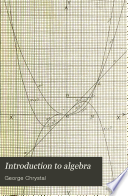 | George Chrystal - Algebra - 1898 - 476 pages
...value of x, and for every such value of xa corresponding algebraic value of y. In the present case у is positive when x is positive, and negative when x is negative. To every point on the x-axis there corresponds a point P. The points P will therefore constitute a... | |
 | Ellery Williams Davis, William Charles Brenke - Calculus - 1912 - 514 pages
...Thus y = x2 is concave upwards everywhere, since 6 = 2 is positive. For y = x3 we find 6 == 6 x, which is positive when x is positive, and negative when x is negative ; hence y = y? is concave upwards at the right, and concave downwards at the left of the origin. A point at... | |
 | Henry Sinclair Hall, Samuel Ratcliffe Knight - Algebra - 1913 - 606 pages
...written in the form 4 from which it appears that when x = 0, у = oo and when x = oo, у = 0. Also у is positive when x is positive, and negative when x is negative. Hence the graph must lie entirely in the first and third quadrants. It will be convenient in this case to take the... | |
 | Maria M. Roberts, Julia Trueman Colpitts - Geometry, Analytic - 1918 - 266 pages
...curve is not symmetrical with respect to the origin. 3rd. Solving for y, It is seen that the numerator is positive when x is positive and negative when x is negative, also that the denominator is positive when x is greater than 2 and negative when x is less than 2,... | |
 | Claude Irwin Palmer, William Charles Krathwohl - Geometry, Analytic - 1921 - 376 pages
...curve y = x2 rising and for what values falling? Solution. — Given y = x2. Then ^ = 2x. dx Now 2x is positive when x is positive, and negative when x is negative. Hence the curve is rising when x>0, and falling when x<0. Example 2. — For what values of x is the function... | |
 | Claude Irwin Palmer - Calculus - 1924 - 476 pages
...curve y = xz rising and for what values falling? Solution. Given y — xí. Then ^ = 2x. dx Then Now 2x is positive when x is positive, and negative when x is negative. Hence the curve is rising when x > 0, and falling when x < 0. The curve is as shown in Fig. 18. Example 2. For... | |
 | Charles Walmsley - History - 1926 - 316 pages
...differentiable for all values of x, and its differential coefficient is 2#; (vi) its differential coefficient is positive when x is positive and negative when x is negative; (vii) it is integrable between 0 and 1, and in fact between any two values a and b; (viii) the area... | |
 | Koninklijke Nederlandse Akademie van Wetenschappen - Natural history - 1927 - 666 pages
...monotonely increasing function of x. From this, in connection with arc tg 0 = 0, it follows that arc tg x is positive when x is positive and negative when x is negative. 5. Formula for arc tg a + arc tg b. We consider the function xb <p (x) — arc tg x — arc tg +bx'... | |
 | Michael Grossman, Robert Katz - Mathematics - 1972 - 108 pages
...function that assigns to each number x the number (xp if x > 0 0 if x = 0 . -(-x)P if x < 0 Note that xP is positive when x is positive, and negative when x is negative. For any numbers y and z, (yz) P = yP. zp, and = y = I If p = 1/2, the pth-power function is the function... | |
 | Edwin Arthur Maxwell - Calculus - 1962 - 288 pages
...sinha; = — sinh( — a;). For sinh ( - x) = \(e~x - e-<-x>) = \ ,(e~x - ex) = —sinh a;. Note. Sinh x is positive when x is positive, and negative when x is negative. For example, if a; is positive, then ex is greater than e~x, since e is greater than 1. Hence \(ex... | |
| |